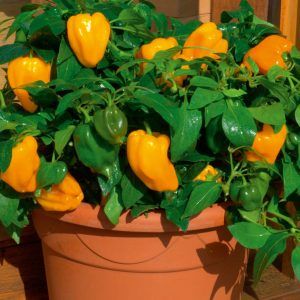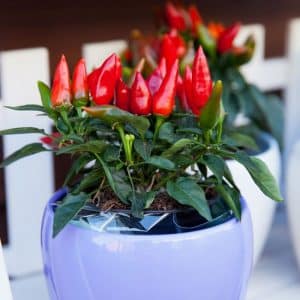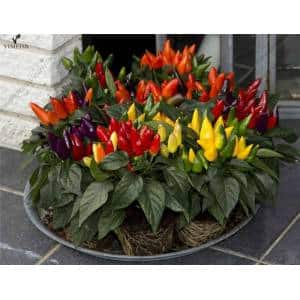How to grow peppers in pots: photos, growing technology and useful tips
There are about 700 species in the genus Pepper (Piper). Gardeners grow Bulgarian sweet, chilli, and hot chili in their garden plots. And those who do not have a summer house can try to do this at home.
The article will tell you how to grow peppers in pots at home and which varieties are suitable for this. This crop will delight you with delicious fruits and decorate your home.
Choosing a variety and seeds for successful cultivation
Types and varieties of peppers for home use growing great multitude. When choosing seeds, consider your taste preferences and conditions in your home. If you cannot devote a lot of time to caring for the plant, choose the most unpretentious and disease-resistant varieties.
Interesting. Black pepper is found among plant collectors. This species belongs to true peppers (from the Piperáceae family), while bell and hot peppers are relatives of eggplant and tomato. The fruits of the plant are small and inconspicuous, but famous throughout the world.
The most popular types of pepper
Sweet and hot varieties deserve special consideration.
Sweet:
- Yarik. Early ripening, ripens on day 85. The fruits are cone-shaped, heavy, up to 6 cm long. The bush needs support.
- Sweetie. Red, small, tomato-like, spherical fruits. They ripen at 115 days. An ornamental variety, but the fruits are edible and sweet.
- Etude. Mid-season (135-140 days). Bush 60-70 cm high. Fruits are produced up to 30-40 pcs.on the bush, red, fleshy, juicy, weighing up to 100 g.
- Curious. Ripens at 65 days. The fruits are bright yellow, cone-shaped, with a pointed tip. Resistant to tobacco mosaic virus.
- Treasure Island. Remontant variety. On day 60, small light green or orange peppers weighing 50 g ripen.
Spicy:
- Tabasco. The bush is up to 45 cm high, densely decorated with yellow and red peppers (6 cm), collected in bunches. The famous sauce is prepared from the fruits.
- Black Pearl. Luxurious decorative variety. As the plant grows, along with the small, bead-like peppers, its color changes from green to purple-black.
- Small miracle. Bush up to 30 cm high. The fruits change color as they ripen. Peppers of cream, green, red and purple colors ripen on the bush at the same time.
- Queen of Spades. Multi-colored hybrid with purple and red peppers. It is distinguished by long-term fruiting and the ability to develop in partial shade.
How to grow indoor peppers from seeds and cuttings
To germinate pepper seeds, the same conditions are created as when sowing plants for seedlings.
Growing peppers from cuttings
Cuttings with 2-3 buds are obtained by regularly pruning the crown and rooted in water with coal. If there are a lot of cuttings, they are rooted in boxes with humus and sand (1:1). Before planting, the lower cut of the shoots is dipped into the Kornevin root former. The plantings are sprayed and covered with film. Rooting occurs in 2-3 weeks.
How to grow peppers at home on a windowsill
Pepper is a very demanding, even capricious plant: it will be easier to grow it if you know the cultural requirements for the conditions of keeping and the subtleties of caring for adult specimens.
Pre-sowing seed preparation
Preparing seeds for sowing helps speed up their germination and ensures healthy seedlings:
- Calibration by size and quality (damaged seeds are not suitable for sowing).
- Germination test. Place pepper seeds in salted water (30-40 g of table salt per 1 liter of water) for 5-7 minutes. Hollow seeds will float to the surface, and viable seeds will sink to the bottom.
- Soak for 10-15 minutes in a 1-2% solution of potassium permanganate.
- Treatment with any growth and root formation stimulator - Epin, Zircon, aloe juice.
Seed germination technology
Seed propagation allows you to plant any variety you like on your window at home:
- Prepared seeds are sown in February in flat containers.
- Sprinkle the top with a thin layer of fertile soil mixed with sand in equal parts.
- Moisten generously from a sprayer.
- Cover with film to create a greenhouse effect. Every day, morning and evening, it is opened for ventilation.
- For smooth emergence of seedlings, maintain a temperature of 24-26°C.
Pepper does not tolerate transplantation well, so it is better to grow the vegetable without picking, sowing it 1-2 seeds at a time in pots.
Preparing the soil and pot
The soil for planting peppers should be nutritious, light in mechanical composition, water- and breathable.
The soil is prepared based on:
- 2 parts humus;
- 1 part peat;
- fertilizers (20 g of urea, 45 g of superphosphate and 25 g of potassium sulfate are added per 1 m2).
The acidity of the earth should be 6-7 pH. If the soil is acidic, add lime or dolomite flour. The soil is spilled with dark pink potassium permanganate and left for 2-3 hours. Then mix again and begin transplanting.
Reference. If it is not possible to prepare the soil, it can be purchased at any flower shop.Ready-made soils for peppers are suitable: “Saintpaulia”, “Begonia”, “For tomatoes and peppers”.
Transplanting young plants to a permanent place
Shoots appear on 6-10 days. The film is removed from the seedlings, the temperature is reduced to 22°C or transferred to a cooler room. When young plants reach a height of 25-30 cm, they are transplanted into a pot of larger diameter.
Drainage in the form of 1.5 cm of fine expanded clay and a thin layer of sand is placed at the bottom of the pot. The soil for replanting is used of the same composition as for seedlings. After planting, the plants are watered with Zircon (1 ampoule per 5 liters of water).
Temperature and ventilation
Pepper has increased requirements for light and heat and cannot withstand strong changes in maintenance conditions:
- temperature – during the day +24…+26°C; at night +18…+20°C;
- air humidity – 65-70%;
- illumination 20-30 thousand lux (additional illumination is necessary in winter at night);
- length of daylight hours – 12-14 hours;
- regular ventilation;
- from May 20 to early August, plants are kept on an open balcony or street, protected from direct sunlight.
At temperatures below 15°C, plants slow down their growth. Heat above 29°C is also destructive, leading to the fall of flowers and ovaries.
Watering and spraying
Peppers need more frequent watering than indoor cherry tomatoes. The moisture-loving vegetable does not tolerate even short-term drying of the soil. But overmoistening the substrate leads to acidification of the soil, the development of fungal diseases and the death of roots. Water the plants when the top layer of soil is dry to a depth of 1 cm.
The air in apartments is often dry, especially in the autumn-winter period. To maintain optimal air humidity, pepper is sprayed with warm water daily.Containers of water are placed on the windowsills in close proximity to the pots. The water evaporating will prevent the leaves from drying out.
Diseases and pests of indoor species
The diseases of indoor peppers are the same as those of their garden counterparts:
- Blackleg dangerous at the seedling stage. It appears as constriction and blackening of the base of the root collar. Plants lie down and die.
- Brown spot. Vague yellow-brown spots appear on the leaves. On the underside of the leaf there is a white coating, which then turns brown.
- Sooty fungus - concomitant disease. It settles on peppers infected by insects that secrete a sticky liquid.
Most diseases are a consequence of improper care and watering. To combat fungal diseases, biological fungicides are used, for example, the drug “Barrier” (20 g per 10 l). Strong fungicides approved for garden treatments cannot be used in the apartment due to long-term toxic effects. In greenhouses, after treatment with a potent drug, they are kept in quarantine for 3 days and do not enter the treated room.
Plants affected by vascular fungal diseases (fusarium and late blight) cannot be cured. They are thrown away, healthy bushes are treated with the specified fungicide for prevention.
Pests affect the crop less often than in the garden. They enter the plants through an open window, along with soil or bouquets of flowers:
- Greenhouse aphid. Leaves curl and plants slow down. A sticky liquid is noticeable on the leaves - insect secretions.
- Whitefly. Numerous small light dots are noticeable on the leaves. With severe damage, the leaves fall off and the bushes look depressed.The leaves become shiny due to the secretions left by the butterflies.
- Spider mite. Numerous punctures and light streaks are visible on the affected leaves - traces of mite bites; the stems and leaves are entangled in cobwebs.
- Root-knot nematode. The plant is stunted and appears drooping with normal watering. Swellings - galls - are visible on the roots.
From pests Traditional methods of control will help - spraying with infusion of garlic, tobacco, a solution of laundry soap, or treatment with the drug “Fitoverm”. Dosage: 2 ml per 1 liter of water. It belongs to hazard class 4 (low toxic drug). Treat on the balcony or in a non-residential area (processes cannot be carried out in the kitchen and bedroom).
Pruning, shaping and harvesting
Peppers do not shoot, but shoots are regularly pinched. The more side branches a plant has, the more abundant the harvest. Crown formation begins during the active growing season, with the exception of the dormant period:
- for seedlings 12-15 cm high, pinch the apical bud to form lateral branches;
- overgrown side shoots are left as the main ones, and weak ones are pinched after the first leaf;
- do the same with the remaining branched shoots of the 2nd and 3rd order;
- in August, all the tips of the shoots are pinched so that the fruits that set become large;
- in October-November, the side shoots are shortened by 1/2-1/3 of their length.
What is decorative pepper
Ornamental pepper (Capsicum) is a subshrub native to South America. The fruits are considered inedible. Plants are grown exclusively for interior decoration. Its numerous fruits ripen in time for Christmas. They cover the entire plant and are brightly colored.
Is it possible to eat decorative peppers?
Small peppers have a hot, bitter taste, but are not poisonous and can completely replace chili seasoning.
Caring for decorative peppers
Care measures are practically no different from caring for any other pepper:
- from February to November - regular watering;
- from November to February – dormant period (watering infrequently, temperature +18…+20°C);
- transplant every 2 years;
- during the fruiting period - regular fertilizing with phosphorus-potassium fertilizers (every 2 weeks);
- pinching and crown formation.
Flowering, growth and fruiting of ornamental peppers
Ornamental peppers bloom more abundantly, with fruits covering the entire plant. At the same time, there are buds on the plants, ovaries and ripened fruits. Fruits on one bush can be of different colors depending on the variety (yellow and red, purple and red). Excess ovaries are not pinched.
Choosing a place in the apartment to grow such peppers
The abundant fruiting of a houseplant depends on the light. Choose places for your pet that are lit throughout the day (south, southwest or southeast windows).
Tips and tricks
Recommendations from experienced gardeners for growing this demanding crop:
- Peppers with large fruits must be tied to a support.
- Do not place sweet and spicy varieties next to each other - as a result of cross-pollination, bushes with sweet peppers will produce bitter fruits.
- Use water for irrigation at room temperature, otherwise the plant's leaves will curl.
Conclusion
Indoor gardening is a popular and promising area of indoor floriculture. Among vegetable crops grown on the windowsill, pepper takes its rightful place.
To get a good harvest of sweet peppers, you will have to make a lot of effort to create favorable conditions - light, temperature. It is easier for beginners to start mastering the culture with decorative, unpretentious varieties.